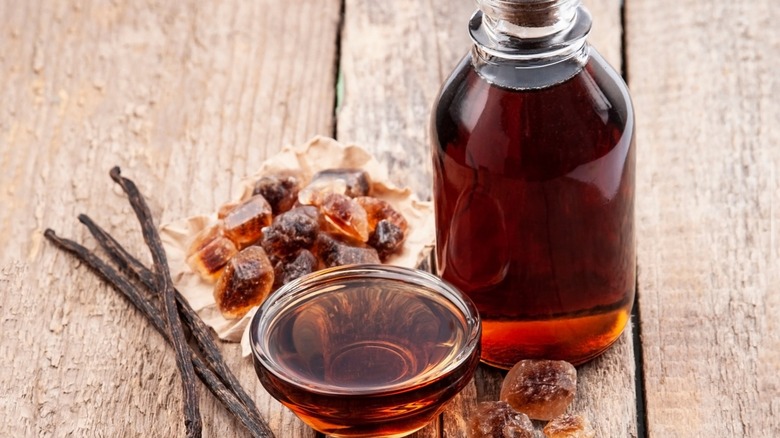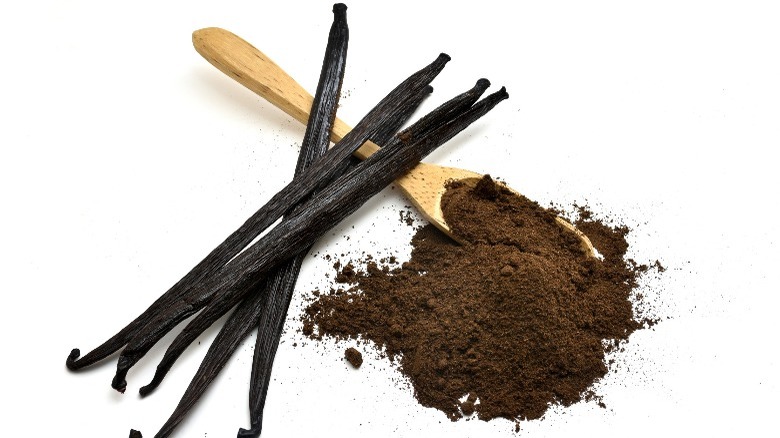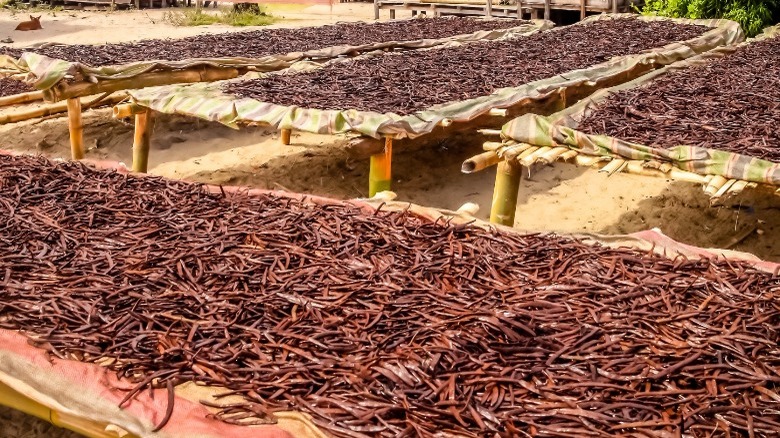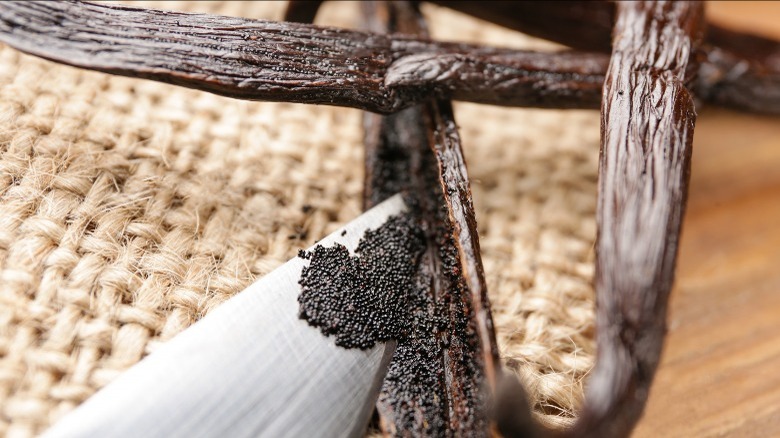The Vanilla Extract Swap For Deeper Flavor
Holiday baking is just around the corner and if you've already been planning your cookie list for the season or dreaming of oven-warmed kitchens, golden-crusted pies, fluffy cakes, and eager faces entranced by the heady scent of vanilla wafting through the house, you might want to hear this. Because according to the Associated Press, when it comes to sugary baked goods, vanilla is foundational. The outlet says, "Vanilla is an essential ingredient like salt, and its usual supporting role is to enhance and bring out the featured flavor."
It goes without saying that this magical spice — yes, it's a spice, per McCormick Science Institute — born of the pod of the Vanilla orchid or Vanilla planifolia is absolutely best when it's real. But debates still rage on as to which region's vanilla beans are superior (Mexico, Madagascar, Tahiti, Indonesia, or Uganda via Pastry Arts Magazine) and whether freshly scraped whole beans, vanilla extract, or vanilla paste yield the ultimate in vanilla flavor (via The Chopping Block). If you search for it, you'll find plenty of advice on which form of vanilla is best to use in what type of recipe. In fact, vanilla purveyor, Nielsen-Massey (selling vanilla for over 110 years) contends that the differences between extract and paste are so distinct, that every budding baker should learn their key features in order to choose the one best suited to their needs.
But if you're really looking to mix in a little wow factor to your favorite holiday treats, try ground vanilla powder.
What is vanilla powder?
The answer to this question is a little bit tricky. Pure ground vanilla bean powder is the stuff sugarplum dreams are made of. Unfortunately though, just like in your dreams, things aren't always as they appear. The first thing you should know is that real ground vanilla bean powder is made by grinding down the leathery, whole dried vanilla bean pods of the vanilla bean plant into a fine powder, intensifying its flavor and making it more convenient for use.
But if you've been paying attention, you might be asking yourself, "Why is vanilla powder white?" The simple answer is — it's not. The more commonly found white or beige powders labeled "vanilla powder," (though they were introduced to the consumer first) are not true, pure ground vanilla bean powder. Instead, they are a variety of different sugar and/or starch combinations that have been sprayed with extracts of vanilla and mixed with anti-caking agents to produce an affordable, easy-to-use vanilla powder (via JL Gourmet Imports and Singing Dog Vanilla). These powders work well when sprinkled on finished baked goods, mixed into frostings, or when you need to retain the color purity of your recipe but it won't get you the deep, rich flavor that comes from ground, sun-dried, and cured, mahogany-colored vanilla bean pods (via Smithsonian Magazine). This is why, though fairly new to the consumer marketplace, food manufacturers have been using vanilla bean powder over extracts for years (via JL Gourmet Imports).
Why use vanilla powder?
Depth of flavor is the main reason to use vanilla powder. Because pure vanilla bean powder is a single-ingredient product, the flavor and scent are both more pronounced going into your baked goods. Vanilla extracts are just that, an extracted flavor of the vanilla bean, either in an alcohol or glycerine base that often dissipates in intensity once placed in the high heat of the oven (via Martha Stewart). Though extracts work wonderfully in baking, when you want to kick that vanilla flavor up, many turn to vanilla bean paste or the caviar scraped from the whole beans. But if you truly want vanilla to take center stage in your recipe, it's pure ground vanilla bean powder that will really make your vanilla sing. Bon Appétit loves its "visual pop," and touts among its many attributes, its easy measuring, and storage capabilities (up to two years via McCormick Science Institute) and points out that ground vanilla bean powder's magic goes well beyond baked goods, encouraging its use in "ice cream bases, puddings, custards, and any other dessert that requires heating."
Institute of Culinary Education chef-instructor, Sandra Palmer suggests using vanilla bean powder in savory dishes, too, " . . . balancing spices like ginger and cardamom," (via Martha Stewart). Vanilla purveyors Vanilla & Spice recommend adding it to your coffee or tea, and even blending some into smoothies or mixing it into oatmeal, while Nielsen-Massey advocates use in tomato relish, and Singing Dog Vanilla suggests it for rubs.
Health benefits of vanilla bean powder
Another great reason to use pure vanilla bean powder may be your health. Healthline reports that several preliminary research studies show vanilla contains antioxidant, anti-inflammatory, anticancer, and neuroprotective effects in animals that could extend to humans. If these results prove true, concentrated forms of real vanilla, like ground vanilla bean powder could offer even more of those potential protective health benefits, making vanilla powder an easy first choice. And pure vanilla bean powder may also help you reduce your added sugar intake when used in place or in part of sugar (via WebMD and Healthline).
But buyer beware, as JL Gourmet Imports cautions not all consumer vanilla bean powders are the same. JL says some powders are made from previously scraped or extracted beans, baked and ground down into vanilla bean powder, a practice said to have started with extract manufacturers who sold the byproduct as a courtesy to their food manufacturing clients who desired the speckled vanilla bean appearance of "whole bean" vanilla in products like ice cream and chai tea that actually used extracts. Though there are whole vanilla bean powder purveyors that do grind whole unscraped, unextracted beans down into a fine powder for sale to consumers, inquire directly with your brand of choice if you have concerns, to be sure you're not paying a premium price for fiber and organic matter bereft of flavor. If you don't want to worry about sourcing, you can make your own vanilla bean powder at home like Lebanese cookbook author and food influencer, Samira Kazan.
How to use vanilla bean powder in a recipe
Although it's true, vanilla bean powder really pumps up the deeply resonate vanilla notes in any dish, it's also more expensive than its more dilute, multi-ingredient counterparts. So, while it may be easy to envision swapping vanilla powder one-for-one for the extract, bean, or paste, it's important to note that because the flavor of pure vanilla bean powder is more concentrated, it should be used in measurements half as much as the original recipe is written. This means if your recipe calls for one teaspoon of vanilla extract, you'd substitute half of a teaspoon of ground vanilla bean powder in its place (via The Kiwi Importer).
Outside of the right measurement advice, the only thing you need to know to use vanilla bean powder in your cooking is your own imagination. You can use this flavorful powder any place you'd use vanilla extract, pod, or paste, and perhaps even more. The possibilities are endless, everything from pancakes, waffles, biscuits, and cornbread to cakes, pies, cookies, and puddings. And vanilla bean powder's dry consistency and lack of added sugar lends itself well to savory things like meat or veggie rubs, risotto, or paired with flour or bread crumbs in fried coatings, stuffings, or even mixed into ground meat recipes like meatloaf or meatballs (via SloFoodGroup).




